Use este identificador para citar ou linkar para este item:
http://biblioteca.incaper.es.gov.br/digital/handle/item/804Registro completo de metadados
| Campo DC | Valor | Idioma |
|---|---|---|
| dc.contributor.author | SOBREIRA, F. M. | pt_BR |
| dc.contributor.author | KROLING, C. A. | pt_BR |
| dc.contributor.author | GUARÇONI, A. M. | pt_BR |
| dc.contributor.author | MOREIRA, S. de S. | pt_BR |
| dc.contributor.author | FAVARATO, L. F. | pt_BR |
| dc.contributor.other | Fabrício Moreira Sobreira, Incaper; Cesar Abel Krohling, Incaper; Andre Guarçoni Martins, Incaper; Suzana de Sá Moreira, Consórcio Pesquisa Café; Luiz Fernando Favarato, Incaper. | pt_BR |
| dc.date.accessioned | 2015-06-30T14:05:55Z | - |
| dc.date.available | 2015-06-30T14:05:55Z | - |
| dc.date.created | 2015 | pt_BR |
| dc.date.issued | 2015-06-30 | pt_BR |
| dc.identifier.other | 7051 | pt_BR |
| dc.identifier.uri | http://biblioteca.incaper.es.gov.br/digital/handle/item/804 | - |
| dc.description | Trabalhos de pesquisa demonstraram maior rendimento da colheita com derriçadoras portáteis em relação a colheita manual. Contudo, não se conhece as possíveis interações entre o rendimento de colheita por meio de derriçadoras portáteis e as cultivares de café arábica. O objetivo deste estudo foi avaliar, sob o sistema de cultivo da cafeicultura de montanha, o rendimento de derriça manual e de modelos de derriçadoras portáteis em relação a cultivares de café arábica. Utilizou-se o delineamento de blocos casualizados, com quatro repetições, sob esquema de parcela subdividida. Na parcela foram avaliadas três cultivares de café arábica (Catuaí Vermelho IAC 44, Siriema Amarelo e Catucaí Amarelo 2 SL). Na subparcela foi avaliado o rendimento de três modelos de derriçadoras e da derriça manual. A parcela foi composta por 14 plantas e a subparcela por três plantas. Os três modelos de derriçador apresentaram rendimento de derriça semelhante entre si nas três cultivares. Em média, os modelos de derriçadoras foram 206 % superiores a derriça manual quanto ao rendimento. No entanto, na cultivar Catucaí A. 2SL o uso de um específico modelo de derriçadora representou em relação a derriça manual, em média, uma redução de 37,4 % no volume de frutos colhidos, nas outras duas cultivares não houve diferença. Os modelos de derriçadora e a derriça manual foram semelhantes quanto a porcentagem de frutos colhida em cada estádio de maturação nas três cultivares. Os modelos atuais de derriçadoras são semelhantes entre si e superiores a derriça manual quanto ao rendimento de derriça. Os derriçadores portáteis podem diferir quanto ao volume total de frutos derriçados na lona de colheita em função das características da cultivar em questão. A possibilidade de perda de frutos pelo uso de determinadas derriçadoras portáteis em combinação com outros fatores (cultivar/relevo e outros), pode proporcionar situações de menor rentabilidade. Research studies showed higher harvest yield with portable coffee harvester in relation to manual harvesting. However, it is unknown the possible interactions between the harvest yield using portable coffee harvester and the coffee arabica cultivars. The objective of this study was to evaluate, under the cropping system of mountain coffee culture , the yield of manual harvest and the yield of portable harvester models in relation to coffee arabica cultivars. We used a randomized complete block design with four replications in a subdivided plot design. In the plot were evaluated three coffee arabica cultivars (Catuaí IAC 44, Siriema Yellow and Yellow Catucaí 2 SL). In the subplot were evaluated the yield of manual harvest and the yield of three coffee harvester models. The plot was constituted by 14 plants and the subplot by three plants. The three coffee harvester models showed similar yield of harvest among each other in the three cultivars. On average, the coffee harvester models showed yield 206% higher than the manual harvesting. However, in the cultivar Catucaí A. 2S the use of coffee harvester in relation to manual harvesting represented, on average, a decrease of 37.4% in volume of harvested fruits, in the other two cultivars there was no difference. The coffee harvester models and the manual harvesting were similar in percentage of fruit harvested in each maturity stage in the three cultivars. The current coffee harvester models are similar among each other and superiors than manual harvesting in relation to harvest yield. The portable coffee harvester may differ in the total volume of fruits harvested at harvesting canvas according to the characteristics of the cultivar. The possibility of loss of fruits with the use of certain portable harvester in combination with other factors (cultivar / relief and others) may lead to lower yield situations. | pt_BR |
| dc.language | pt_BR | pt_BR |
| dc.publisher | In: SIMPÓSIO DE PESQUISA DOS CAFÉS DO BRASIL, 9., 2015, Curitiba. Consórcio pesquisa café: oportunidades e novos desafios. Brasília, DF: Embrapa Café, 2015. | pt_BR |
| dc.subject | Derriça semi-mecanizada | pt_BR |
| dc.subject | Colhedora | pt_BR |
| dc.subject | Derriça manual | pt_BR |
| dc.subject | Siriema | pt_BR |
| dc.subject | Derriçadoras | pt_BR |
| dc.title | Rendimento de derriçadoras portáteis na colheita de cultivares de café Arábica. | pt_BR |
| dc.type | -- | pt_BR |
| dc.ainfo.id | 6664 | pt_BR |
| dc.ainfo.lastupdate | 2015-06-30 | pt_BR |
| dc.ainfo.depositante | Merielem Frasson | pt_BR |
| dc.subject.nalthesaurus | Semi-mechanized harvesting | pt_BR |
| dc.subject.nalthesaurus | Harvester | pt_BR |
| dc.subject.nalthesaurus | Manual harvesting | pt_BR |
| dc.subject.nalthesaurus | Siriema | pt_BR |
| Aparece nas coleções: | Memória Técnica do Incaper  | |
Arquivos associados a este item:
| Arquivo | Descrição | Tamanho | Formato | |
|---|---|---|---|---|
| 167.pdf | 239,91 kB | Adobe PDF |  Visualizar/Abrir |
Os itens no repositório estão protegidos por copyright, com todos os direitos reservados, salvo quando é indicado o contrário.
